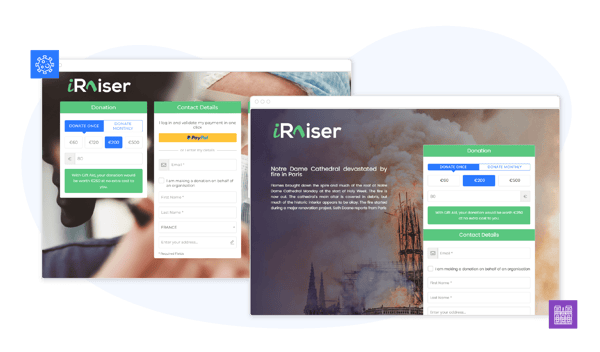When a disaster or crisis situation occurs, the key to a successful fundraising appeal is to be very reactive and move quickly. You must launch your campaign, communicate about it and mobilise your donors within the first few days, if not hours.
Your responsiveness to an unexpected event will have a major impact on:
- the success of your appeal: be present on social networks, in Google search results (organic or paid),
- your image: show your donors that your organisation is agile and structured to face crises and respond to needs when they arise.
In this guide, we will give you the keys to a successful emergency appeal:
1. Emergency situations: what are we talking about?
2. How to be ready and responsive in time of crisis? The 7 areas to work on beforehand
3. Failure to Act: what impact could it have on your non-profit organisation?
Emergency situations: What are we talking about?
 According to Wikipedia, “is an urgent, unexpected, and usually dangerous situation that poses an immediate risk to health, life, property, or environment and requires immediate action.”
According to Wikipedia, “is an urgent, unexpected, and usually dangerous situation that poses an immediate risk to health, life, property, or environment and requires immediate action.”
When we think of potential crises or emergency situations, we think of wars, natural disasters - events that put people's lives in immediate danger.
Unfortunately, there are many other situations that also fit this description: Notre Dame, fires in the Amazon or Covid-19.
Some campaign examples or types of crisis: Notre Dame, Covid-19, Crise Ukrainienne
How to be ready and responsive in time of crisis? The 7 areas to work on beforehand.
The Afghan crisis, Covid-19, the war in Ukraine and the various emergencies caused by climatic phenomena - the last few years have been marked by numerous crises. The sense of urgency: this also applies to your organisation. In a future emergency situation, your organisation may be on the frontline and should be agile and quick to launch a dedicated campaign in the very first moments after a crisis.
That is why it is crucial for your organisation to be ready to take action by following the three pillars below.
🔝 Your digital fundraising tools
Below are the 7 areas to work on now:
 Internal organisation: Emergency situations or an unforeseen event can disrupt your usual work organisation. You must therefore define a crisis management plan in advance, ready to be deployed if necessary. A clear chain of command will allow you to be agile in your decision-making and therefore to launch your campaigns more quickly.
Internal organisation: Emergency situations or an unforeseen event can disrupt your usual work organisation. You must therefore define a crisis management plan in advance, ready to be deployed if necessary. A clear chain of command will allow you to be agile in your decision-making and therefore to launch your campaigns more quickly.
In order to avoid any confusion during these moments, it is also necessary for your team members to know his or her role. Should we carry out our tasks as usual or should we be involved in the response to the crisis? And more generally:
- Who does what?
- Who is responsible for what?
- Who replaces whom in case of absence?
 The Budget: Setting up a campaign involves expenses. Rather than wasting time, which is precious when a crisis occurs, asking for quotes and other estimates to see how much money is needed, and then having a dedicated budget approved, prepare your budget beforehand. This will allow you to launch your various campaigns and actions efficiently and with little delay.
The Budget: Setting up a campaign involves expenses. Rather than wasting time, which is precious when a crisis occurs, asking for quotes and other estimates to see how much money is needed, and then having a dedicated budget approved, prepare your budget beforehand. This will allow you to launch your various campaigns and actions efficiently and with little delay.
The Communication Plan: Creating a complete and effective communication plan for a campaign in less than 24 hours? Let's face it, it's impossible, especially if you want to continue to carry out your day-to-day activities, including campaigns that are already underway.
In order not to be caught off guard when a crisis occurs, we strongly recommend that you prepare your communication plan in advance:
- Emails
- Visuals
- Posts for social media
- Graphic Guidelines dedicated to emergencies
- communication channels (social networks, google ads, etc.)
- A page on your website
In addition to being able to launch your campaign as quickly as possible, you won't have to disrupt your usual organisation by seeking approvals from the whole organisation for the campaign material.
If your campaign materials and crisis communication plan are ready, you will have to replace some elements to adapt them to the crisis in question but 80% of the work will already be done.
 Donor Segmentation: Just like your communication plan, your segmentation should already be defined. In a normal situation, you do not address your donors in the same way depending on their age, their sensitivity to certain causes, their donation preferences, etc. The same rules apply to emergency campaigns. Preparing your different segments allows you to optimise your online fundraising from the very beginning.
Donor Segmentation: Just like your communication plan, your segmentation should already be defined. In a normal situation, you do not address your donors in the same way depending on their age, their sensitivity to certain causes, their donation preferences, etc. The same rules apply to emergency campaigns. Preparing your different segments allows you to optimise your online fundraising from the very beginning.
Digitalisation and Internal Communication: Digitalising your organisation, and therefore your tools, will help you get the right messages to the right people quickly. The various lockdowns brought about by Covid-19 have set a precedent, you now know the importance of being able to communicate remotely, via instant messaging or video conferencing.
Apart from those tools mentioned above, such as Teams, Google chat, Slack or Zoom, Google Meet, other digital tools can be very useful for project management: Trello, Monday, Notion - and are often available with a free version.
Your digital fundraising tools: Your current donation forms are up and running, but what happens if a crisis occurs? Here are the questions you need to ask yourself:
Can you create multiple donation forms, specific to your different campaigns?
It is imperative that you have the ability to create different donation pages for each campaign and even for each of your segments.
In the particular case of emergency situations, you need to adapt your fundraising page to convey the right message, and adapt the graphic guidelines (if you have some dedicated to crises).

💡We advise you to prepare several donation pages dedicated to crisis management: one for each segment. This will allow you to tailor the message according to the type of donors you are addressing and facilitate their giving journey.
- Can your fundraising solution handle the traffic load? As we saw when the conflict in Ukraine broke out, a major crisis, the influx of traffic is sudden and heavy. Even more so if you have followed all our advice and your campaign is live in a few hours or if you launch a TV campaign.
You need to be 100% sure that your donation page can handle the traffic load. What's worse than a page that's down in a state of emergency?
In February and March 2022, numerous organisations contacted us because their fundraising pages could not handle the surge in traffic and the gifts they were receiving were being blocked.
- Are the keywords for your paid search campaigns ready? Giving visibility to your campaign is key but you mustn't waste time. Here again, timeliness is of the essence.
Prepare lists of keywords on which you can bid beforehand. On the day, all you have to do is adapt these lists with the name of the emergency in question and launch. Do you have an agency? Ask them now to identify the right keywords.
- Do you have a Peer-to-Peer platform? In the event of a crisis, a Peer-to-Peer campaign will allow you to respond to requests from supporters who wish to help you in more ways than just making a donation. Via this campaign, they can launch their own personal fundraising page in the name of your association.
If you have a Peer-to-Peer platform for emergencies already set up, you will save precious time. Once the messages have been adapted and the platform has been launched, your supporters can begin raising funds from their personal and/or professional networks.
Finally, as mentioned in the communication plan, your website, messages and visuals for social media must also be ready.
Lack of action: what impact could it have on your non-profit organisation?
Not reacting to an emergency situation can have a negative impact on your image, especially if it is related to the cause you are supporting or if you are considered a "crisis" organisation.
Indeed, if a disastrous event occurs, your supporters might visit your website hoping to donate to it. Imagine their disappointment if there is no mention of it and no dedicated donation page is published. Your brand image would suffer greatly.
This is why it is imperative that you do this preparation work and prepare for crisis management.
If your association is not in the front line, you can still act and support or relay the efforts and actions of other charities. Your supporters will appreciate the initiative.
If there is only one thing you should remember from this guide, it is this: BE RESPONSIVE!
Want more advice on fundraising and raising money for your cause? Get in touch with us! Our experts will give you all the advice you need to create effective donation form templates for emergency situations - and much more!
